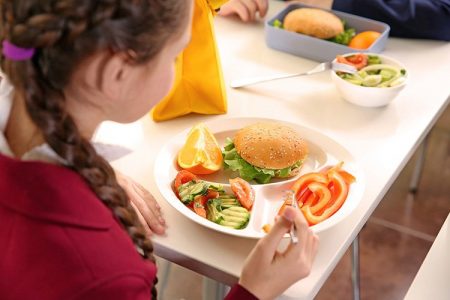How Does School Lunch Work?
How the National School Lunch Program Works
 All different kinds of schools participate in the National School Lunch Program (NSLP), like public schools, non-profit private schools and residential child care centers. The federal government reimburses schools and school districts that participate a certain amount of money for each meal they serve. That amount depends on if the meal is a free, reduced-price or full-price meal.
All different kinds of schools participate in the National School Lunch Program (NSLP), like public schools, non-profit private schools and residential child care centers. The federal government reimburses schools and school districts that participate a certain amount of money for each meal they serve. That amount depends on if the meal is a free, reduced-price or full-price meal.
Here’s the catch: To get the money, schools must provide meals that meet nutrition standards, and they have to offer free or reduced-price meals to kids that qualify. Schools can get extra money (6 cents each meal—it all adds up!) if they meet the newest federal meal standards. So beyond improving the health and learning of students, there’s a lot of incentive for schools to ensure kids are participating in the school lunch program.
A few other things to know
- Calorie requirements per lunch vary by grade:
- Kindergarten through fifth-grade students get 550-650 calories
- Sixth through eighth-grade studentes get 600-700 calories
- Ninth through 12-grade students get 750-850 calories
- Fats are limited, allowing for no trans fats and not more than 10{f49ae73af5159ead47becd8f5ce8e5fb559299506316fc057ccc964bc975f557} of calories from fat.
- Schools were required to slowly decrease sodium levels by 2022, but this requirement was delayed in 2017.
- Kids must have access to free drinking water in the cafeteria during lunch.
Has school lunch really gotten healthier?
The Healthy, Hunger-Free Kids Act of 2010 (HHFKA) secured historic reforms to school meals and the entire school food environment. Improving child nutrition was the focal point of this landmark legislation. It authorized funding and set policy for USDA’s core child nutrition programs including the NSLP, the School Breakfast Program (SBP) and the Summer Food Service Program, among others. To get those extra pennies from the government, school meals must contain:
- 1 half-cup serving of fruits or veggies. Veggies can be a legume (like beans, peas), dark green AND red or orange once per week.
- Grains must be 51{f49ae73af5159ead47becd8f5ce8e5fb559299506316fc057ccc964bc975f557} or more whole grain, though some schools can request an exemption.
- One cup of fat-free (skim) or low-fat (1{f49ae73af5159ead47becd8f5ce8e5fb559299506316fc057ccc964bc975f557}) milk. Flavored milk must be fat-free.
A 2019 USDA study showed that thanks to the Healthy, Hunger-Free Kids Act, nutritional quality of meals is up from a score of 58 to 81, kids are NOT throwing away more food, and lunch participation is higher for schools with healthier meals. Read more about the findings here.
Categories: Meals & Nutrition